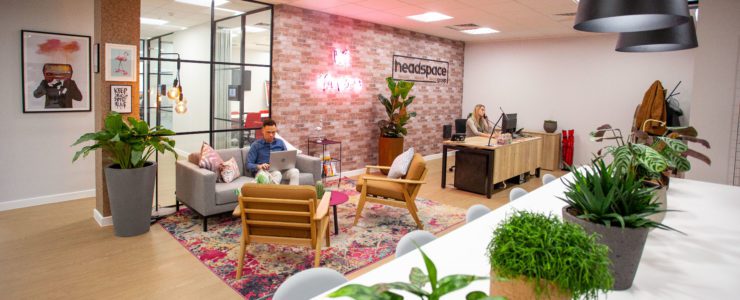
Is coworking the future?
The coworking movement is celebrating its 15th anniversary this year – and despite the challenges posed by the coronavirus pandemic, it’s still on track to become the future of the business world.
Coworking has thrived over the years since software engineer Brad Neuberg first wrote about his idea for people to “come together in community” and cowork. His groundbreaking personal blog was published on 9th August 2005 on his Coding in Paradise site.
How did coworking begin?
Perhaps ironically, it was a global health crisis, in the shape of an outbreak of avian influenza, that led Neuberg to come up with the idea. The virus began in Vietnam in January 2005 – leading to millions of infected birds being euthanised – and gradually spread across the world, in much the same way as Covid-19 has.
In his blog, Neuberg, who was working at a start-up called Rojo at the time, wrote about how many people were forced to work from home in isolation, threatened not only by the global health crisis but also by stress, loneliness and anxiety.
He spoke about how society traditionally forced us to choose between working in a 9 to 5 job for a company or working from home for ourselves. He feared although the office environment provided structure and community, it was at the expense of losing our freedom and having no control over our life.
Working from home for ourselves gave us independence, but left us suffering from loneliness and getting into bad habits because we weren’t surrounded by a work community. The solution? A hybrid of the two. Neuberg concluded in his blog: “Coworking is a solution to this problem.”
How much has coworking changed since?
Coworking has grown phenomenally since the world’s first coworking space opened in 2005 at Spiral Muse in San Francisco – which Neuberg described as “amazing”. Coworkers would sit at a table, or relax on a couch, as they worked. Even though they were working on separate projects, they had a sense of community and could run ideas past each other.
The ethos remains the same today but has grown rapidly to encompass millions of people. In 2017, there were around 1.18 million workers using coworking spaces across the globe. Today, the figure has grown to 3.1 million people – and this number is estimated to rocket to more than five million over the next few years.
The global success of coworking could easily have led to its downfall when Covid-19 struck at the start of 2020. The very nature of collaboration that marks a successful coworking space, bringing multiple people together to share amenities under one roof, seemed at odds with these times of lockdown and physical distancing.
However, not only has coworking weathered the storm, it’s also finding its way back, becoming stronger than ever. Its collaborative spirit is a strength, rather than a weakness. Owners and workers are sharing knowledge, swapping resources and supporting each other to come up with safe working practices.
Measures such as reduced capacity spaces, smaller meetings, socially distanced workstations, single-use utensils, one-way systems, flexible spaces and plenty of deep-cleaning mean coworking spaces are able to welcome members back safely.
What could coworking achieve in the next 15 years?
Industry insiders say this is the beginning of a new chapter, as coworking starts to find its way back, adapting to the “new normal” that people all over the world are having to navigate.
Businesses are becoming more open to their employees working in a coworking environment, ironically as a direct result of the pandemic. The one potential positive to come out of the crisis is a workforce that’s more widely distributed, rather than working in the traditional office environment.
Workers look set to have more mobility and flexibility in their jobs, with coworking spaces becoming a new trend. We’ve proved we have the technology to escape the 9 to 5 routine, thanks to working from home, video conferencing and all the other aspects of life during lockdown that we’ve had to overcome.
For some people, coworking will mean having a shorter commute to work, a change of scenery and meeting new people. Experts are predicting many new coworking spaces will have opened up to meet an increasing need, even within the next five years.
Which big businesses have chosen coworking?
People in all sectors appreciate working in a non-office environment, where all the amenities they need are at their fingertips. A fast internet connection, printing facilities and a set-up that promotes creativity and collaboration are among the main advantages.
While many people think of start-ups and small companies using coworking spaces, an increasing number of big businesses are joining the trend too.
For example, tech giants Microsoft and IBM are ditching formal offices in favour of vibrant coworking community space. The travel web platform Wanderfly and the social networking site Instagram have also attributed their meteoric rise to success to coworking.
Over the next 15 years, we can expect to see the demand for coworking increase rapidly. The prediction is that over the next few years, businesses, institutions and the infrastructure will start to adjust to the “new normal”. The way companies manage their workspace will shift from the amount of office space they own to how they can successfully ensure the wellbeing and productivity of a flexible workforce.
Nobody knows what the future will bring, in terms of the world recovering from the current pandemic, so it follows that having the ability to use a flexible coworking space when needed, rather than investing in contracted bricks-and-mortar properties, will be the most popular choice.
© goodluz / Shutterstock.com

![gallery-manchester-13062018-6-1024×683[1]](https://www.headspacegroup.co.uk/wp-content/uploads/2021/04/gallery-manchester-13062018-6-1024x6831-1-740x300.jpg)

